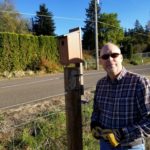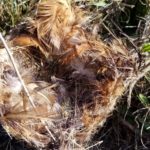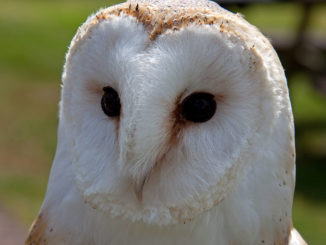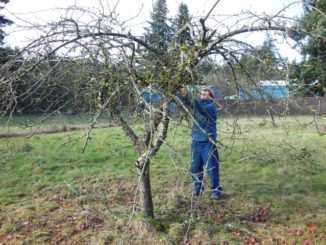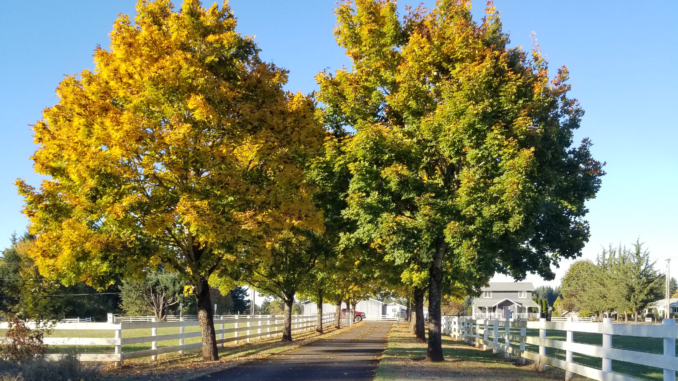
The first day of fall was nearly a month ago but we have been blessed with incredible weather since then. This update is in two parts: status of the 15-acre Beavercreek Farm property and then the status of the Conservation Resource Center project.
Beavercreek Farm
Flag is down for the season
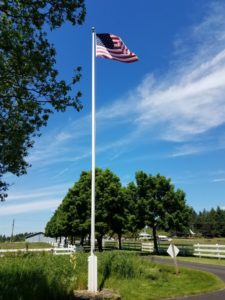
We try to raise the flag for the summer around Memorial Day and take it down around Labor Day. This year, with all of the other big initiatives the District is involved in, we didn’t get around to taking the flag down until early in October.
The latest flag has survived three summers at the Farm and is ready to be retired. The image to the left is from May 2017 when the flag was still bright and vibrant. The intense summer of 2018 caused it to fade quite a bit.
With construction scheduled at the Farm for next year, we probably won’t be flying a flag in 2019. The new facility will have a new flagpole with internal halyards to reduce the noise of halyards slapping on the hollow metal pole. You should see a new flag flying in 2020.
Trees planted

The Pudding River Watershed Council had some leftover Willamette Valley Ponderosa pine (Pinus ponderosa var. willamettensis) trees in pots. They donated eight trees to the District. So far, we have planted three in the southeast corner of the property and three in the northeast corner. The remaining two may end up in the northwest corner of the property.
Eventually, these trees will provide tall perches for birds of prey (kestrels, hawks, and owls). We want them at the farm to help control rodents in the fields.
Birdhouses cleaned out
Bluebird nest boxes erected in 2014 along the Ferguson Road and Beavercreek Road fences were cleaned out, making them ready for new occupants next spring. We found moss, grass, and feather nests. Chickadees build a moss nest. Grass-and-feather nests are usually built by tree swallows and violet-green swallows.
Grass nests are, we hope, from western bluebirds. (For more information about monitoring bluebird nest boxes, see this information sheet from the North American Bluebird Society.) We did see chickadees and swallows using the nests this year, and one District employee reported seeing a bluebird going in and out of one of the nests. Barn swallows nest every spring underneath the historic barn.
This month, we also spotted a kestrel perched on top of the kestrel nest box we erected a few years ago. We would love to see some baby kestrels at the farm.
We will be watching for leftover lumber during the construction of the Conservation Resource Center that we can use to build a barn owl nesting box. Barney the Barn Owl has been a regular user of the historic barn for the five years the District has owned the property. If Barney is really Barnadette, we’d like to encourage reproduction of barn owls at the farm!
Blackberry treated
We treated blackberry vines a few seasons ago around the farm. Some are coming back, most visibly along the boundary fences. Staff treated blackberry along Beavercreek and Ferguson roads a week ago so we should see them die back over the winter.
Conservation Resource Center
Building permit in November
We expect to submit the building permit for the Conservation Resource Center in November 2018. Our construction timeline has become tighter. If we submit the permit in November and Clackamas County takes four months to process it, we’ll be breaking ground in March 2019. We estimate a 10-month construction period, so a four-month permit process means we can start moving in around Christmas 2019.
However, if the County takes six months to approve the permit, then we won’t be able to move in until February 2020, and that is when our current office lease expires. With a six-month permit process, our construction timeline has no slippage available.
Siding change in the conceptual design
The most significant visual change in the conceptual design occurred in September when the District chose to switch from vertical board-and-batten siding to horizontal lap siding.

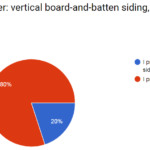 District Board members and employees were asked to respond to a simple poll on this design choice. Responses strongly favored the horizontal siding. For low maintenance and fire resistance, we are planning to use fiber cement lap siding.
District Board members and employees were asked to respond to a simple poll on this design choice. Responses strongly favored the horizontal siding. For low maintenance and fire resistance, we are planning to use fiber cement lap siding.
As you drive into the property on the driveway, you will be driving toward the main entrance shown on the left side of the image above. The right side of the image shows a separate office entrance that we plan to build for a conservation partner. Bringing them along means the Conservation Resource Center will truly be a center for conservation services.
Driveway expansion
We hope to retain some of the original driveway. It will have to be widened to create two lanes. Clackamas County wants it to be aligned with a driveway across the road, so the current plan is to remove the eastern row of Norway maples to allow expansion of the driveway. Testing of the current driveway and base has not been completed, though, so we don’t know if we can simply widen the driveway or if we’ll have to rebuild it. Widening the driveway in one direction will allow us to keep the western line of Norway maple trees.
Other significant design changes are noted in the update published in August.
Hazardous materials
An assessment of hazardous materials in the farmhouse, garage, wood shed, old shop, and carriage house was recently completed. The only material of concern was some asbestos in the linoleum flooring in the farmhouse. That will be relatively easy to mitigate prior to moving the structure or demolishing it.
Feedback is welcome
We welcome your feedback about the farm and the Conservation Resource Project.
